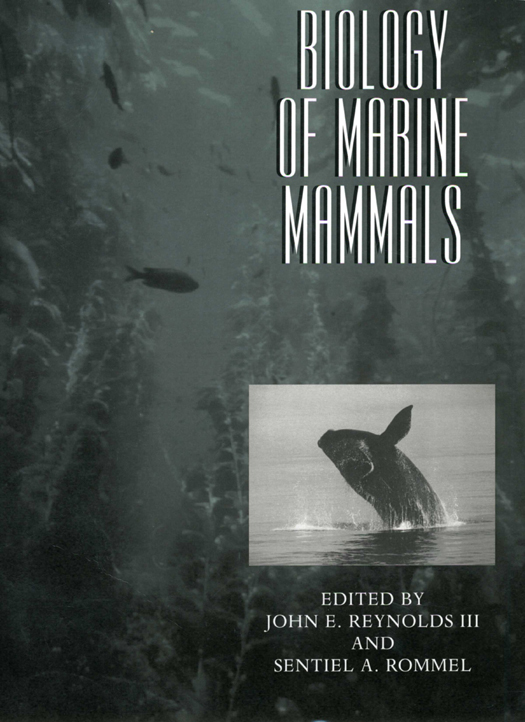John E. Reynolds III - Biology of Marine Mammals
Here you can read online John E. Reynolds III - Biology of Marine Mammals full text of the book (entire story) in english for free. Download pdf and epub, get meaning, cover and reviews about this ebook. year: 1999, publisher: Smithsonian, genre: Home and family. Description of the work, (preface) as well as reviews are available. Best literature library LitArk.com created for fans of good reading and offers a wide selection of genres:
Romance novel
Science fiction
Adventure
Detective
Science
History
Home and family
Prose
Art
Politics
Computer
Non-fiction
Religion
Business
Children
Humor
Choose a favorite category and find really read worthwhile books. Enjoy immersion in the world of imagination, feel the emotions of the characters or learn something new for yourself, make an fascinating discovery.

- Book:Biology of Marine Mammals
- Author:
- Publisher:Smithsonian
- Genre:
- Year:1999
- Rating:3 / 5
- Favourites:Add to favourites
- Your mark:
- 60
- 1
- 2
- 3
- 4
- 5
Biology of Marine Mammals: summary, description and annotation
We offer to read an annotation, description, summary or preface (depends on what the author of the book "Biology of Marine Mammals" wrote himself). If you haven't found the necessary information about the book — write in the comments, we will try to find it.
Biology of Marine Mammals — read online for free the complete book (whole text) full work
Below is the text of the book, divided by pages. System saving the place of the last page read, allows you to conveniently read the book "Biology of Marine Mammals" online for free, without having to search again every time where you left off. Put a bookmark, and you can go to the page where you finished reading at any time.
Font size:
Interval:
Bookmark:


1999 by the Smithsonian Institution
All rights reserved
Copy editor: Danielle Ponsolle
Production editor: Duke Johns
Designer: Janice Wheeler
Library of Congress Cataloging-in-Publication Data
Biology of marine mammals / edited by
John E. Reynolds III and Sentiel A. Rommel.
p. cm.
Includes bibliographical references (p.).
eISBN: 978-1-58834-420-5
1. Marine mammals. I. Reynolds, John Elliott, 1952
II. Rommel, Sentiel A.
QL713.2.B54 1999
599.5dc21
98-27808
British Library Cataloguing-in-Publication Data available
For permission to reproduce illustrations appearing in this book, please correspond directly with the owners of the works, as listed in the individual captions. The Smithsonian Institution Press does not retain reproduction rights for these illustrations individually, or maintain a file of addresses for photo sources.
v3.1
Preface
JOHN E. REYNOLDS III
JOHN E. REYNOLDS III, DANIEL K. ODELL, AND SENTIEL A. ROMMEL
D. ANN PABST, SENTIEL A. ROMMEL, AND WILLIAM A. MCLELLAN
ROBERT ELSNER
DOUGLAS WARTZOK AND DARLENE R. KETTEN
DANIEL P. COSTA AND TERRIE M. WILLIAMS
IAN L. BOYD, CHRISTINA LOCKYER, AND HELENE D. MARSH
PETER L. TYACK
RANDALL S. WELLS, DARYL J. BONESS, AND GALEN B. RATHBUN
W. DONALD BOWEN AND DONALD B. SINIFF
THOMAS J. O SHEA
My introduction to marine mammal science and policy occurred in the autumn of 1974 when I took a class taught by Dan Odell at the University of Miamis Rosenstiel School of Marine and Atmospheric Science. At the time little did I appreciate the rare opportunity I had to take one of the few such courses in existence. Even today there are so few formal courses on the subject that a survey carried out by the Society for Marine Mammalogy showed that the majority of marine mammalogists with Ph.D.s have never taken one.
Between 1975 and 1980 I worked as a teaching assistant in Dans course. Although my primary responsibility was teaching marine mammal anatomy laboratories, I began to consider how I would teach different aspects of marine mammalogy; my musings crystallized in 1980 when I was hired by Eckerd College and was charged with precisely that task.
Development of a coherent course that dealt with both science and policy was hindered in 1980 by lack of a comprehensive textbook. The same holds true as I write this in 1998, despite the existence of more and more books on marine mammals. Some contain excellent species accounts; others are highly technical discussions of particular topics; a few are appropriate for use as texts, except that they deal with only a subset (e.g., cetaceans) of the marine mammals or with only those species in a particular geographic area; many are nontechnical coffee-table books with stunning photographs but inadequate text to be useful for students. In short, people who teach, or want to teach, marine mammalogy continue to be frustrated that a comprehensive textbook for upper-level undergraduate and graduate students is still unavailable.
This deficiency befuddles many marine mammalogists. The field itself matured remarkably during and after the 1970s. Marine mammal science historically involved a lot of field observations, some excellent anatomical studies, and some physiological investigations. The first Marine Mammal Conference, held in 1975 in Santa Cruz, California, attracted only some 150 scientists. A decade later, the field had grown sufficiently that the Society for Marine Mammalogy was created, along with its own publication, Marine Mammal Science. Topics covered in the journal still address traditional scientific questions (e.g., estimates of abundance, causes of mortality, physiological adaptations, social behavior, functional anatomy, stock discreteness, and effects of human activities), but do so using technology (e.g., telemetry, polymerase chain reaction, electron microscopy, geographic information systems) that allows greater resolution. The 11th Biennial Conference on the Biology of Marine Mammals, held in 1995 in Orlando, Florida, attracted some 1500 participants, an order of magnitude more than the conference two decades earlier.
The growth of scientific research has been paralleled in terms of policy and conservation. In 1972 the Marine Mammal Protection Act was adopted by the U.S. Congress. The Act was noteworthy both for its focus on marine mammals and its approach to management from an ecosystem point of view. This and other legislation (e.g., the Endangered Species Act of 1973) provide a legal framework for conserving and managing marine mammal stocks and habitats. Over the years recovery plans, which consider both science and socioeconomics, have been developed for a number of endangered or threatened species. A 1994 workshop sponsored by the U.S. Marine Mammal Commission articulated a set of guiding principles for the worldwide conservation of marine mammals and other living natural resources.
In addition the lay public grew increasingly interested in marine mammals during the past three decades. Marine mammals have become symboliceven mystical. Marine zoological parks and aquaria display marine mammals and develop educational and conservation messages for the public; people who might never see an ocean, and yet as voters could impact issues involving marine mammals, can see and learn firsthand about these animals. Television documentaries feed the appetite of a public that wants to know more about marine mammals and how to save them. Special interest groups have taken up the cause over the years; for example, such groups contributed to efforts to establish a moratorium on worldwide commercial whaling.
Despite the whirlwind of scientific advances, promulgation of policy, and public interest, there has continued to be a dearth of college-level courses to either groom future marine mammal managers and scientists or to enlighten future professionals in related fields (e.g., marine ecology, fisheries biology, epidemiology) for whom an overview of marine mammalogy would be useful. The few existing courses have been handicapped by the lack of a comprehensive text.
Biology of Marine Mammals provides a straightforward, integrated approach to understanding these animals. Most chapters consider topics one would expect in a biology textbook, including functional morphology, physiology, sensory biology, energetics, reproduction, communication, behavior and ecology. A chapter that is perhaps less typical, but which is very useful for students to understand marine mammal biology, is the final chapter on toxicants and their possible effects on marine mammal health.
Font size:
Interval:
Bookmark:
Similar books «Biology of Marine Mammals»
Look at similar books to Biology of Marine Mammals. We have selected literature similar in name and meaning in the hope of providing readers with more options to find new, interesting, not yet read works.
Discussion, reviews of the book Biology of Marine Mammals and just readers' own opinions. Leave your comments, write what you think about the work, its meaning or the main characters. Specify what exactly you liked and what you didn't like, and why you think so.








